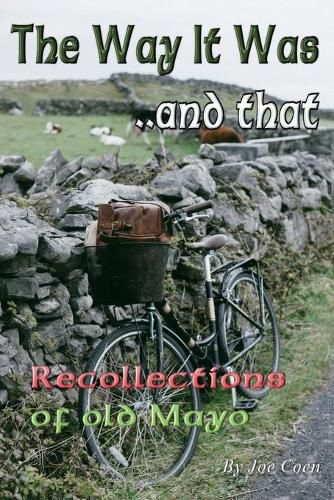Readings Newsletter
Become a Readings Member to make your shopping experience even easier.
Sign in or sign up for free!
You’re not far away from qualifying for FREE standard shipping within Australia
You’ve qualified for FREE standard shipping within Australia
The cart is loading…






This title is printed to order. This book may have been self-published. If so, we cannot guarantee the quality of the content. In the main most books will have gone through the editing process however some may not. We therefore suggest that you be aware of this before ordering this book. If in doubt check either the author or publisher’s details as we are unable to accept any returns unless they are faulty. Please contact us if you have any questions.
Aghamore, Co. Mayo during the War years. Most of the grown-ups in my time had learnt how to ride a bicycle, and so bicycles were fairly plentiful. However the period of which I speak was during the Second World War years, and so bicycles and parts for them became scarce and most expensive. Those who had wealth could always find a good bicycle to buy, but the poor had to improvise. I remember seeing bicycles parked outside the church with pedals made of a square piece of wood. Tyres too had to be invented to match the new circumstance. Sometimes little discs of old tyres were strung together with wire rather like a string of daisies, and these, when fitted on the bicycle wheels, acted as solid tyres. Others used to twist a rope of hay and wrap it around the rim of the wheels and then fit an old tyre on over the hay rope. Somehow we all learnt how to ride a bicycle, and the burning ambition of most young people was to have a bicycle of their own. The first bicycle that I owned was a fairly basic model. It had two good wheels and a new chain, and one good brake. Extravagances like handgrips or carriers were not essential. Later I graduated to a bicycle with a three-speed gear and a hub dynamo.
Very soon the days of the bicycle were over. Bright colours or even five-speed gears did not satisfy. The bicycles were abandoned under the hedges to rot away and everybody aspired to have at least one motor car in the household. I must admit that like the rest of men I too succumed to the craze of the motor car.
And so begins this storybook of nostalgic recollections of what it was like to grow up in rural Co. Mayo during the War years. Another gem from Joe Coen following on from the equally-charming, Two Dry Sods - Tales from Old Mayo .
$9.00 standard shipping within Australia
FREE standard shipping within Australia for orders over $100.00
Express & International shipping calculated at checkout
This title is printed to order. This book may have been self-published. If so, we cannot guarantee the quality of the content. In the main most books will have gone through the editing process however some may not. We therefore suggest that you be aware of this before ordering this book. If in doubt check either the author or publisher’s details as we are unable to accept any returns unless they are faulty. Please contact us if you have any questions.
Aghamore, Co. Mayo during the War years. Most of the grown-ups in my time had learnt how to ride a bicycle, and so bicycles were fairly plentiful. However the period of which I speak was during the Second World War years, and so bicycles and parts for them became scarce and most expensive. Those who had wealth could always find a good bicycle to buy, but the poor had to improvise. I remember seeing bicycles parked outside the church with pedals made of a square piece of wood. Tyres too had to be invented to match the new circumstance. Sometimes little discs of old tyres were strung together with wire rather like a string of daisies, and these, when fitted on the bicycle wheels, acted as solid tyres. Others used to twist a rope of hay and wrap it around the rim of the wheels and then fit an old tyre on over the hay rope. Somehow we all learnt how to ride a bicycle, and the burning ambition of most young people was to have a bicycle of their own. The first bicycle that I owned was a fairly basic model. It had two good wheels and a new chain, and one good brake. Extravagances like handgrips or carriers were not essential. Later I graduated to a bicycle with a three-speed gear and a hub dynamo.
Very soon the days of the bicycle were over. Bright colours or even five-speed gears did not satisfy. The bicycles were abandoned under the hedges to rot away and everybody aspired to have at least one motor car in the household. I must admit that like the rest of men I too succumed to the craze of the motor car.
And so begins this storybook of nostalgic recollections of what it was like to grow up in rural Co. Mayo during the War years. Another gem from Joe Coen following on from the equally-charming, Two Dry Sods - Tales from Old Mayo .